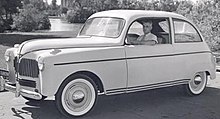The Soybean car, more recently referred to as the Hemp body car, was a car build with agricultural plastic and was fueled with hemp combustible (oil or ethanol). Although the formula used to create the plasticized panels has been lost, it is conjectured that the first iteration of the body was made partially from soybeans and Hemp. The body was lighter and therefore more fuel efficient than a normal metal body.
It was made by Henry Ford's auto company in Dearborn, Michigan, and was introduced to public view on August 13, 1941.
History:
Henry Ford first put Eugene Turenne Gregorie of his design department in charge of manufacturing.Ultimately he was not satisfied with the proposed project, and gave the project to the Soybean Laboratory in Greenfield Village. The person in charge there was Lowell Overly, who had a background in tool and die design. The finished prototype was exhibited in 1941 at the Dearborn Days festival in Dearborn, Michigan. It was also shown at the Michigan State Fair Grounds the same year. Patent 2,269,452 for the chassis of the soybean car was issued January 13, 1942.
Because of World War II all US automobile production was curtailed considerably, and the plastic car experiment basically came to a halt. By the end of the war the plastic car idea went into oblivion. According to Lowell Overly, the prototype car was destroyed by Bob Gregorie.
Others argue that Ford invested millions of dollars into research to develop the plastic car to no avail. He proclaimed he would "grow automobiles from the soil" — however it never happened, even though he had over 12,000 acres of soybeans for experimentation. Some sources even say the Soybean Car wasn't made from soybeans at all — but of phenolic plastic, an extract of coal tar. One newspaper even reports that all of Ford's research only provided whipped cream as a final product.
Reasoning for a plastic car:
The Henry Ford Museum gives three reasons for Ford's decision to make a plastic automobile, the plastic car made from soybeans.- Ford was looking to integrate industry with agriculture;
- Ford claimed that his plastic made these cars safer than normal metal cars;
- Ford wished to make his new plastic material a replacement for the metals used in normal cars. A side benefit would have been easing of the shortage of metal during World War II.
Car ingredients:
The frame of this automobile was made of tubular steel, to which were attached some fourteen plastic panels, said to be "only a quarter of an inch (6 mm) thick." The windows were made of acrylic sheets. All of this led to a reduction in weight from 2500 pounds for a typical car to 1900 pounds, a reduction in weight of about 25 per cent.The exact ingredients of the plastic are not known since there were no records kept of the plastic itself. Speculation is that it was a combination of soybeans, wheat, hemp, flax and ramie. Lowell Overly, the person who had the most influence in creating the car, says it was "...soybean fiber in a phenolic resin with formaldehyde used in the impregnation."
Internet video:
A report circulating on the Internet shows a film from 1941 about the plastic car in the opening credits as being the plastic soybean car, but at the end part it shows images of Henry Ford striking a hammer or axe onto a trunk lid. It is not the Soybean Car he is hitting, but Ford's personal car with a plastic panel of the same material on the trunk, and the hammer had a rubber boot placed on the sharp end of the ax. When Jack Thompson, the narrator of the 1941 black & white film, stated in the introduction that this was the Soybean Car being shown he did not make it clear that the trunk Henry Ford was hitting with the tool at the end of the film was actually Ford's personal car made of the same plastic material—not the Soybean Car itself. Henry Ford was doing this demonstration to show the toughness of the plastic material. The demonstration was dramatic, since the tool rebounded with much force and a picture of this was shown worldwide.External Links:
Ford, Henry; Gregorie, Eugene T. (January 13, 1942). "Patent 2,269,452, Automobile Chassis Construction". United States Patent Office.
Woodyard, Chris (June 29, 2010). "Mystery Car 40: Henry Ford's soybean car". USA TODAY. Retrieved October 20, 2012.
Davis, Josh (January 18, 2011). "Henry Ford’s Hemp Car Re-Examined". hemp.com. Retrieved October 19, 2012.
"Henry Ford and the soybean car". Bayblab October 29, 2012. July 24, 2007.
Benson Ford Research Center (2011). "Soybean Car". The Henry Ford. Retrieved October 20, 2012. including an extensive bibliography.
- The Soybean Car chapter in The Henry Ford web site..
- The Hemp Car - Myth Busted
- A drag race car in 2011 which plastic body panels were partially made of soy-based material.
Footnotes:
Quotes:
- "Why use up the forests which were centuries in the making and the mines which required ages to lay down, if we can get the equivalent of forest and mineral products in the annual growth of the (hemp) fields?"—Henry Ford



No comments:
Post a Comment